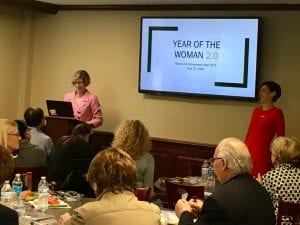
The SMU Tower Center hosted Dr. Victoria DeFrancesco-Soto, lecturer at the LBJ School of Public Affairs, to discuss her insights regarding the second flood of female candidates–Year of the Woman 2.0–and what this means for the future of political parity in the U.S.
Women were at the forefront of the 2016 presidential election not only with Hillary Clinton as the first female candidate of a major party, but also because of her opponent’s history of mistreatment toward women. The release of the Access Hollywood tapes made the issue viral. Candidate Trump responded to the uproar by bringing women who accused Bill Clinton of harassment back into the spotlight.
Treatment of women remained a hot topic following the election, with the Harvey Weinstein scandal leading to the #metoo movement and many resignations from political and business leaders accused of abusing their power and harassing women. Women got angry–but it wasn’t the first time.
Year of the Woman 1.0
The first Year of the Woman was in 1992 when a record number of women ran for public office following outrage caused by Anita Hill’s testimony to the Senate Judiciary Committee in the confirmation hearings for the then Supreme Court nominee Clarence Thomas. Hill accused Thomas of sexually harassing her when he was her employer, but the committee didn’t take her remarks seriously.
Since the push in the ’90s elected women in Congress has risen from less than 10 percent to 19 percent in the House and 21 percent in Senate. But, even with the potential boost from this year’s surge in candidates, parity remains elusive.
1992 vs. 2018
DeFrancesco-Soto listed a few differences and similarities between 1992 and 2018. Unlike in 1992, now there are workplace harassment policies in place as well educational policies, and though women have yet to reach equal pay, earnings for women are much higher. What’s the same? The surge in female candidates is the result of anger after men behaved badly, and there is still a large disparity between male and female representatives.
After Mississippi sent Cindy Hyde-Smith to fill Rep. Cochran’s seat, the U.S. hit a record number of women in the Senate–23. This is good news, DeFrancesco Soto said, but it’s also bad news that in 2018 our record is 20 percent. She expects a bump after the 2018 midterm elections, anywhere from 5 to 8 percent, possibly bringing women to one third of representation, but she says parity is still far in the future.
Barriers for Potential Women Representatives
Even though women outvote men–and have for the last four decades–female candidates still struggle with being elected. Several barriers exist, DeFrancesco-Soto said.
- First, incumbency: right now reelection rates are at 95 percent, so it can be difficult for a female candidate to break into a male-owned seat.
- Second, money in politics is becoming increasingly important for candidates to be successful, and research shows that women are less likely to ask for funding at early stages of their campaigns. Funding from the very beginning is essential, DeFrancesco-Soto said.
- Third, stereotyping in the media still exists. “Why do we need to know what Hillary Clinton’s wearing?” DeFrancesco-Soto asked. She argued this issue has gotten better, but it’s still a disadvantage women face.
- Fourth, it is hard for women to figure out the timing of their run. Family planning and family responsibilities still fall more heavily on women’s shoulders, though there has been some positive change in this regard as well.
Other barriers include gender specific socialization, a lack of viable role models, and a lack of political confidence, largely due to the specific socialization of boys versus girls.
2018 and Beyond
Even with these obstacles, 309 women filed to run representing a major party in Congressional elections this year. Forty women filed to run for governorships. This are both record numbers.
Two Texas women to watch are: State Senator Sylvia Garcia, Congressional District 29, and Veronica Escobar, Congressional District 16. Both women won their primaries outright, and if either wins her election, Texas will have elected its first Latina representative to Congress.
DeFrancesco-Soto ended her talk with a push for a change in the infrastructure to achieve gender parity. She said that while emotion is always the strongest force to encourage political action, “anger alone can’t cut it.” Instead, she said that the U.S. needs a stronger pipeline of candidates in both parties, better training programs, and more donations for women candidates. Finally, she said, “Everyone needs to vote in the runoff.”